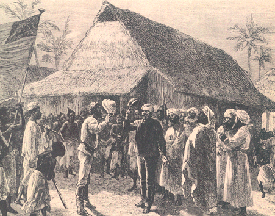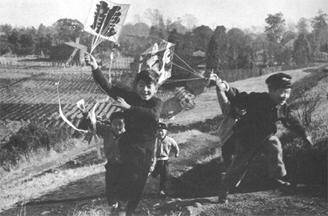|
| When a Southern Historian Disdains Robert E. Lee |
The Southern Historian
Hair:
Brown and short
Height: Average
Weight: Average
Age: Young
enough that he never had to worry about being drafted and sent off to
Vietnam.
Country of Origin: Southern Baptist
Occupation: The
scholarly pursuit of Dame History
Hobbies: Golf. He also enjoys
being a block monitor of hot water consumption
|
 |
Above:
David finds the fabled "Lost People" of the land of BigSofa
and attempts to refine their debating skills on American History. One
will notice an extra figure in the rendering, which is the gray ghost of
the Southern General Robert E. Lee, which has followed David around
since he disdained specializing in the Civil War for early Nineteenth
Century American History. "I am not a killer," General Lee
endlessly repeats in his attempt to convince David he was an excellent
strategist. |
Below:
David, having fought in defense of the Puritans, preserves Thanksgiving
and ensures that he may forever enjoy turkey. |
 |
It
occurs to me that David (the Southern Historian) would enjoy living in Japan, and despite his
passion for American History I don't imagine he would miss America all
that much. I don't know why--perhaps because he has disdained Robert E. Lee--a vision came to me recently of David
sitting on a tatami mat in front of a low Japanese table, enjoying a
typical Japanese meal with some Japanese. To be more precise, David, now
teaching American History at a Japanese university (or something down
that line), is having one of his regular once-a-week meals over at the
apartment of a fellow professor. The fellow professor and his wife have
taken David under their wing, and the dinners which were originally a
matter of professional and social obligation quickly evolved to be a
matter of friendly habit. Each week the discussions continue on into the
night a little later, and a little later, until finally, with the help
of a little too much sake, the wife of the Japanese professor is falling
asleep on the floor while the two colleagues continue with their
bantering at the table, voices sometimes raised too high as they debate
on whether or not it was the ghost of Robert E. Lee which disguised
himself as Christ and appeared to the Native Americans, bringing with
him plans for the Ghost Dance religion and intentions of stirring up
trouble in the West.
David
has been in Japan a year or two at this point. Soon, he will
unexpectedly meet and fall in love with a Japanese woman. They will
marry and have children. Eventually, David will become fed up with the
city and, like an increasing number of Japanese, will move to the back
country, the western region, the hinterland of Japan, in search of a
closer-to-nature, slower-paced life. This will be made possible by his
now being a published scholar who is able to write in such a way that
Everyman can pick up one of David's books and enjoy the tragic-comedy of
American History. He will become the Carl Sagen of American History.
An
eccentricity of David's, which will entertain his Japanese wife, is that
he will insist upon celebrating the North American Thanksgiving Holiday
each year. There will be turkey, cranberry sauce, giblet gravy, yams,
mashed potatoes, squash casserole and pumpkin pie. They will have
friends and neighbors over. David will become famous in America for his
friendly, non-academic Everyman books on American History, while in the
western region of Japan he will become famous for his yearly
Thanksgiving feast.
|
 |
| Above:
A heart-warming scene from the back-country of Japan, to which David
will flee in his desire to get closer to nature. |
As
for the photographs of Thanksgiving past and present, both were taken
from Disney's Wonderful World of Knowledge, Volume 11, copyright
1971 as an updated and enlarged English version of an encyclopedia
printed in the Italian language by Arnaldo Mondadori.
The
caption of the photograph in which there is a dead duck resting atop
many pumpkins reads, An American family dressed as Pilgrims act out
the first Thanksgiving. You will notice, however, that the little
girl has on black patent leather Maryjanes. One would think that if they
went through the trouble of hunting and shooting a duck for the photo
that they could have dressed the girl in shoes a little more realistic
than Maryjanes. Also, the right pantaloon leg of the little boy is
hitched higher than his left leg. This is not a mistake; it is a secret
code, just as the little girl's Maryjanes are actually a secret code.
Indeed, it is a little-known fact that the pilgrims still existed in
this country as a cult as late as the early twentieth century, held
together by a refusal to let go of the baroque. One prank of theirs was
the Priory of Sion. Another was the notion of the Native Americans
possessing a language which they communicated by hand signs and smoke
signals. It was the pilgrims and puritans themselves who, far too
immersed in Baroque ideology, had long employed subversive codes so that
they might communicate to each other secretly in public, even when they
were the only public about. Ann what's-her-name (the Quaker) infuriated her fellow
Puritan and Pilgrim brethren by teaching Helen Keller this secret code, which is why she was run out of town.
Assorted People |
|
|

